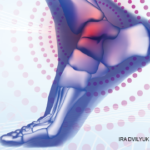Although every surgeon has different criteria, Dr. McCormick says he prefers to perform TAA on patients who are 55 or older and who have low to moderate activity levels.
“With younger patients, there is a greater risk of wearing out the ankle prosthesis quicker,” Dr. McCormick says. “Someone who is young and runs marathons would be a better candidate for ankle fusion.”
After an overnight stay in the hospital, Ms. Davis went home to begin her recovery, a process that lasts six weeks for most TAA patients.
“Within 10 days after my surgery, I was pain free,” says Ms. Davis, who used a cane to avoid putting weight on her ankle. She attended regular physical therapy sessions and by March, Ms. Davis had resumed playing sports, including tennis.
“I couldn’t have asked for better results,” Ms. Davis says. “I spent two years not being able to wear cute shoes because I was in such debilitating pain. One of the first things that I did when I was able to walk unassisted after surgery was to go shoe shopping.”
The Future of Ankle Replacement Surgery
Although it doesn’t have the same long-term track record as hip or knee replacement surgery, Dr. Rush says shorter-term studies on the newer devices used for ankle replacement surgery are very promising, with the newer generation of implants anticipated to last 10–15 years.
This past May, the Hospital for Special Surgery (HSS) in New York announced it had received a grant from the American Orthopedic Foot and Ankle Society to compare the biomedical differences in function between patients who underwent TAA with those who received ankle fusion.2 Dr. Rush notes that other studies are being conducted to determine the lifespan of TAA implants.
“We know that while the plastic lining of the implant may wear out after several years, it can often be replaced without revising the metal components,” Dr. Rush says. “Ankle arthritis is one of the most debilitating health conditions, and one that affects all areas of a patient’s life. We’ve seen how TAA can offer patients the chance to live pain free and walk with ease again.”
Linda Childers is a health writer located in the San Francisco Bay Area of Northern California.
References
- Landro L. More patients opt to replace ankle joints instead of fusion: Increased range of motion; expect repeat surgery a decade later. The Wall Street Journal. 2014 Nov 24.
- Hospital for Special Surgery. Researchers at hospital for special surgery receive grant to study health outcomes of ankle fusion versus replacement.

